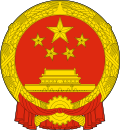Nationality community
Nationality communities ( Chinese 民族鄉 / 民族乡 , Pinyin Mínzúxiāng ) are administrative units at the community level in the People's Republic of China .
The municipality level is in the administrative structure of the People's Republic of China under the district level. It is made up of large municipalities , municipalities , nationality municipalities , street districts , sum , administrative area offices and a nationality sum . At this level there are currently 40,497 administrative units (as of December 31, 2013), of which 1,035 nationality communities or nationality sum (2.56%).
Just as the sum in the areas of Inner Mongolia, which is dominated by migratory livestock, is the equivalent of the communities in arable farming areas, the nationality sum is the inner Mongolian equivalent of the nationality community.
In the meantime, due to their increased population and a certain degree of urbanization in the center of the settlement, nationality communities have occasionally been converted into "nationality large communities" (民族 镇). However, these are neither recorded in a separate category nor statistically counted among the larger municipalities (镇).
According to the Constitution of the People's Republic of China and the Chinese "Law on National Territorial Autonomy" (民族 区域 自治法), wherever it is not possible or not useful due to the small number and dispersed distribution of ethnic minorities , Autonomous Areas , Autonomous Districts or To found autonomous circles , nationality communities to be created. Nationality communities do not belong to the autonomous administrative divisions. However, there are some special rights associated with this status. This also means that the mayor of a community of nationalities should and usually is a member of the titular nationality. The higher-level bodies have to grant national communities special economic development and to give special support in the areas of culture and education.
distribution
Nationality communities exist primarily where several nationalities live in mixed settlement areas or where a small number of one nationality lives in an area dominated by another nationality. There are (effective date: December 31, 2013):
- 215 nationality churches in Guizhou ,
- 141 nationality churches in Yunnan ,
- 98 nationality communities in Sichuan ,
- 97 nationality communities in Hunan ,
- 60 nationality churches in Liaoning ,
- 59 nationality communities in Guangxi ,
- 56 nationality churches in Heilongjiang ,
- 50 nationality churches in Hebei ,
- 42 nationality communities in Xinjiang ,
- 34 nationality communities in Gansu ,
- 28 nationality communities each in Jilin and Qinghai ,
- 19 nationality communities in Fujian ,
- 17 nationality communities in Inner Mongolia ,
- 14 nationality communities each in Chongqing and Zhejiang ,
- 12 nationality parishes in Henan ,
- 10 nationality communities in Hubei ,
- 9 nationality communities each in Tibet and Anhui ,
- 8 nationality communities in Jiangxi ,
- 7 nationality communities in Guangdong ,
- 5 nationality churches in Beijing ,
- 1 national community each in Jiangsu and Tianjin and
- no nationality communities in Shandong , Shanghai , Ningxia , Hainan , Shaanxi and Shanxi .
literature
- Meyer's Atlas China. On the way to world power. Bibliographisches Institut AG: Mannheim 2010. ISBN 978-3-411-08281-0 , pp. 92-93.
- Shen, Lin 沈 林: 中国 的 民族乡Zhongguo de minzu xiang (The National Churches of China). Beijing 2001. ISBN 7-105-02846-7 .
- Tiemu'er 铁木尔 [Teimur] u. Zhao, Xianren 赵 显 人 [ed.]: 中国 民族乡 统计 分析 与 对策 研究Zhongguo minzu xiang tongji fenxi yu duice yanjiu (statistical analysis and research on measures of the nationality communities of China). Beijing 2002. ISBN 7-105-05335-6 .
- Yin Zhongqing (尹中卿): The political system in China today. China Intercontinental Press: Beijing 2004. ISBN 7-5085-0470-4
